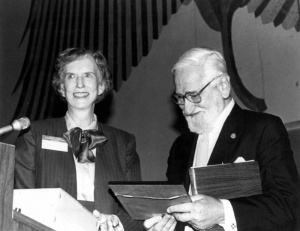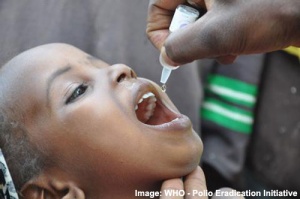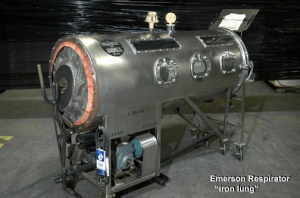Abnormal Development - Polio Virus
| Embryology - 27 Apr 2024 |
|---|
| Google Translate - select your language from the list shown below (this will open a new external page) |
|
العربية | català | 中文 | 中國傳統的 | français | Deutsche | עִברִית | हिंदी | bahasa Indonesia | italiano | 日本語 | 한국어 | မြန်မာ | Pilipino | Polskie | português | ਪੰਜਾਬੀ ਦੇ | Română | русский | Español | Swahili | Svensk | ไทย | Türkçe | اردو | ייִדיש | Tiếng Việt These external translations are automated and may not be accurate. (More? About Translations) |
| Educational Use Only - Embryology is an educational resource for learning concepts in embryological development, no clinical information is provided and content should not be used for any other purpose. |
Introduction
Poliomyelitis (polio) is a highly infectious viral disease, affecting only humans of any age, but mainly children under the age of 3 (> 50% cases). There are three types (type 1, type 2, and type 3) of wild poliovirus which can invade the nervous system and can cause total paralysis in several hours. In areas with either poor hygiene or sanitation, infants are infected early in life, acquiring active immunity while still protected by maternal antibodies. Other infants who miss early contact with the virus become susceptible to infection as maternal antibodies fall.
The Nobel Prize in Physiology or Medicine in 1954 was awarded jointly to John Franklin Enders, Thomas Huckle Weller and Frederick Chapman Robbins.
- "for their discovery of the ability of poliomyelitis viruses to grow in cultures of various types of tissue."
Some Recent Findings
|
| More recent papers |
|---|
|
This table allows an automated computer search of the external PubMed database using the listed "Search term" text link.
More? References | Discussion Page | Journal Searches | 2019 References | 2020 References Search term: Polio Virus |
| Older papers |
|---|
| These papers originally appeared in the Some Recent Findings table, but as that list grew in length have now been shuffled down to this collapsible table.
See also the Discussion Page for other references listed by year and References on this current page. |
Polio Infection
This enterovirus enters the body through the mouth and multiplies in the intestine. Initial symptoms are fever, fatigue, headache, vomiting, stiffness in the neck and pain in the limbs.
Irreversible paralysis (mainly legs) occurs in 1 in 200 infections. Amongst those paralysed, 5%-10% die when their breathing muscles become immobilized. Although polio paralysis is the most visible sign of polio infection, fewer than 1% of polio infections ever result in paralysis. Poliovirus can spread widely before cases of paralysis are seen. As most people infected with poliovirus have no signs of illness, they are never aware they have been infected. After initial infection with poliovirus, the virus is shed intermittently in faeces (excrement) for several weeks. During that time, polio can spread rapidly through the community.
(text modified from - Polio Eradication Organization)
History

- 1908 Karl Landsteiner and Erwin Popper (Viennese scientists) first identify polio as caused by a virus.
- 1916 An epidemic of polio in New York heightens concern on both sides of the Atlantic Ocean and accelerates research into how the disease is spread.
- 1931 Macfarlane Burnet and Jean MacNamara identify several types of poliovirus, known as Types 1, 2, and 3.
- 1952 Dorothy Horstmann shows that poliovirus reached the central nervous system through the bloodstream.
- 1954 John Franklin Enders, Thomas Huckle Weller and Frederick Chapman Robbins win Nobel Prize in Physiology or Medicine for growing polio virus in culture.
- 1955 Jonas Salk develops the first vaccine against polio, an inactivated and injectable polio vaccine.
- 1961 Albert Sabin develops a "live" oral vaccine against polio.
Vaccine
Two types of polio vaccine:
- Inactivated polio vaccine (IPV) - given as an injection (polio virus used in vaccine is killed).
- Live oral polio vaccine (OPV) - a liquid that is swallowed (virus used in vaccine is attenuated or weakened).
American Academy of Pediatrics Committee on Infectious Diseases
Poliovirus Recommendations[2]
- "Despite marked progress in global polio eradication, the threat of polio importation into the United States remains; therefore, all children should be protected against the disease."
- standard schedule for poliovirus immunization remains 4 doses of inactivated poliovirus vaccine at 2, 4, and 6 through 18 months and 4 through 6 years of age.
- minimum interval between doses 1 and 2 and between doses 2 and 3 is 4 weeks
- minimum interval between doses 3 and 4 is 6 months.
- minimum age for dose 1 is 6 weeks.
- Minimal age and intervals should be used when there is imminent threat of exposure, such as travel to an area in which polio is endemic or epidemic.
- final dose in the inactivated poliovirus vaccine series should be administered at 4 through 6 years of age, regardless of the previous number of doses administered before the fourth birthday, and at least 6 months since the last dose was received.
Polio Reports
September 2011
Confirmed international spread of wild poliovirus from Pakistan. (WHO)
- "Wild poliovirus type 1 (WPV1) genetically linked to virus currently circulating in Pakistan has been isolated in China. Pakistan is affected by nationwide transmission of WPV1, and is the location of the only wild poliovirus type 3 (WPV3) case in Asia in 2011 (a strain on the verge of elimination on the continent). As at 13 September 2011, Pakistan had reported 84 cases, compared to 48 cases for the same period in 2010."
June 2006
Report of polio outbreak in Namibia national health authorities are preparing a response to an outbreak of wild poliovirus in Namibia, polio-free since 1996.
May 2005
Report of polio outbreak in Indonesia Indonesia has not had a wild poliovirus case since 1995, which suggests recent introduction of a wild poliovirus form an overseas source. Global polio cases 1267 for 2004 (as of week 26 April 2005): Nigeria (792) India (136) Pakistan (53) Niger (25) Afghanistan (4) Egypt (1) (Polio Eradication Org 04 May 2005) (More? Polio Eradication Initiative)
Countries
- Endemic countries - have never stopped transmission of wild poliovirus. (Afghanistan, India, Nigeria, Pakistan)
- Countries with re-established transmission - have active and persistent poliovirus transmission of more than 12 months following an importation. (Angola, Chad, Democratic Republic of the Congo)
- Countries with imported poliovirus - are experiencing ongoing outbreaks following an importation.(China, Congo, Côte d'Ivoire, Gabon, Guinea, Kenya, Liberia, Mali, Mauritania, Nepal, Niger)
References
- ↑ Pons-Salort M, Burns CC, Lyons H, Blake IM, Jafari H, Oberste MS, Kew OM & Grassly NC. (2016). Preventing Vaccine-Derived Poliovirus Emergence during the Polio Endgame. PLoS Pathog. , 12, e1005728. PMID: 27384947 DOI.
- ↑ 2.0 2.1 American Academy of Pediatrics Committee on Infectious Diseases. (2011). Poliovirus. Pediatrics , 128, 805-8. PMID: 21949143 DOI.
- ↑ <pubmed>22028632</pubmed>
- ↑ <pubmed>21698038</pubmed>| PMC3117421
Reviews
Verdijk P, Rots NY & Bakker WA. (2011). Clinical development of a novel inactivated poliomyelitis vaccine based on attenuated Sabin poliovirus strains. Expert Rev Vaccines , 10, 635-44. PMID: 21604984 DOI.
Breman JG, de Quadros CA, Dowdle WR, Foege WH, Henderson DA, John TJ & Levine MM. (2011). The role of research in viral disease eradication and elimination programs: lessons for malaria eradication. PLoS Med. , 8, e1000405. PMID: 21311582 DOI.
Alvis N, De la Hoz F & Narváez J. (2010). [Economic impact of introducing the injectable inactivated polio vaccine in Colombia]. Rev. Panam. Salud Publica , 27, 352-9. PMID: 20602069
Lauring AS, Jones JO & Andino R. (2010). Rationalizing the development of live attenuated virus vaccines. Nat. Biotechnol. , 28, 573-9. PMID: 20531338 DOI.
Baxter D. (2010). Vaccine responsiveness in premature infants. Hum Vaccin , 6, 506-11. PMID: 20519938
Ehrenfeld E, Modlin J & Chumakov K. (2009). Future of polio vaccines. Expert Rev Vaccines , 8, 899-905. PMID: 19545205 DOI.
Singh P, Das JK & Dutta PK. (2008). Eradicating polio: it's feasibility in near future?. J Commun Dis , 40, 225-32. PMID: 19579713
Sutter RW, Prevots DR & Cochi SL. (2000). Poliovirus vaccines. Progress toward global poliomyelitis eradication and changing routine immunization recommendations in the United States. Pediatr. Clin. North Am. , 47, 287-308. PMID: 10761505
Articles
Okeibunor J, Nsubuga P, Salla M, Mihigo R & Mkanda P. (2016). Coordination as a best practice from the polio eradication initiative: Experiences from five member states in the African region of the World Health Organization. Vaccine , 34, 5203-5207. PMID: 27381643 DOI.
Redondo N, Sanz MA, Welnowska E & Carrasco L. (2011). Translation without eIF2 promoted by poliovirus 2A protease. PLoS ONE , 6, e25699. PMID: 22003403 DOI.
Combelas N, Holmblat B, Joffret ML, Colbère-Garapin F & Delpeyroux F. (2011). Recombination between poliovirus and coxsackie A viruses of species C: a model of viral genetic plasticity and emergence. Viruses , 3, 1460-84. PMID: 21994791 DOI.
Shulman LM, Sofer D, Manor Y, Mendelson E, Balanant J, Salvati AL, Delpeyroux F & Fiore L. (2011). Antiviral activity of 3(2H)- and 6-chloro-3(2H)-isoflavenes against highly diverged, neurovirulent vaccine-derived, type2 poliovirus sewage isolates. PLoS ONE , 6, e18360. PMID: 21904594 DOI.
Fitzgerald KD & Semler BL. (2011). Re-localization of cellular protein SRp20 during poliovirus infection: bridging a viral IRES to the host cell translation apparatus. PLoS Pathog. , 7, e1002127. PMID: 21779168 DOI.
Search Pubmed
Search Pubmed Nov 2011 "Polio Virus" All (14366) Free Full Text (3815) Review (913)
Search Pubmed: Polio Virus
| Environmental Links: Introduction | low folic acid | iodine deficiency | Nutrition | Drugs | Australian Drug Categories | USA Drug Categories | thalidomide | herbal drugs | Illegal Drugs | smoking | Fetal Alcohol Syndrome | TORCH | viral infection | bacterial infection | fungal infection | zoonotic infection | toxoplasmosis | Malaria | maternal diabetes | maternal hypertension | maternal hyperthermia | Maternal Inflammation | Maternal Obesity | hypoxia | biological toxins | chemicals | heavy metals | air pollution | radiation | Prenatal Diagnosis | Neonatal Diagnosis | International Classification of Diseases | Fetal Origins Hypothesis |
External Links
External Links Notice - The dynamic nature of the internet may mean that some of these listed links may no longer function. If the link no longer works search the web with the link text or name. Links to any external commercial sites are provided for information purposes only and should never be considered an endorsement. UNSW Embryology is provided as an educational resource with no clinical information or commercial affiliation.
- Global Polio Eradication Initiative "The goal of the Global Polio Eradication Initiative is to ensure that no child will ever again know the crippling effects of polio. The Global Polio Eradication Initiative is the largest public health initiative the world has ever known."
- WHO Polio
- UNICEF - Polio Info
- Infectious Disease Society of America (IDSA)
- Nobel Prize 1954 - Medicine "ability of poliomyelitis viruses to grow in cultures of various types of tissue."
Glossary Links
- Glossary: A | B | C | D | E | F | G | H | I | J | K | L | M | N | O | P | Q | R | S | T | U | V | W | X | Y | Z | Numbers | Symbols | Term Link
Cite this page: Hill, M.A. (2024, April 27) Embryology Abnormal Development - Polio Virus. Retrieved from https://embryology.med.unsw.edu.au/embryology/index.php/Abnormal_Development_-_Polio_Virus
- © Dr Mark Hill 2024, UNSW Embryology ISBN: 978 0 7334 2609 4 - UNSW CRICOS Provider Code No. 00098G


